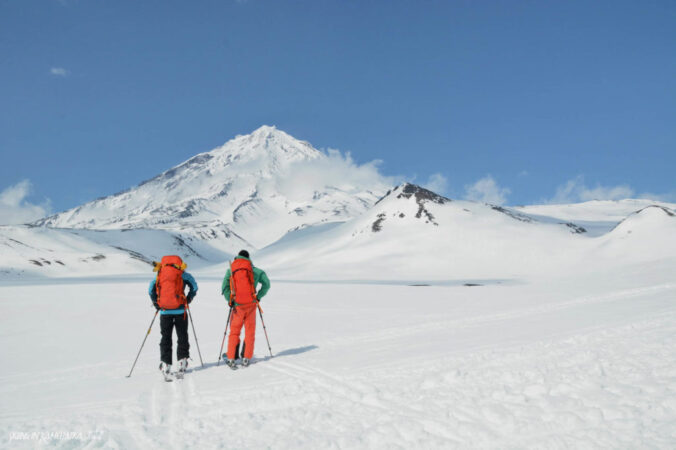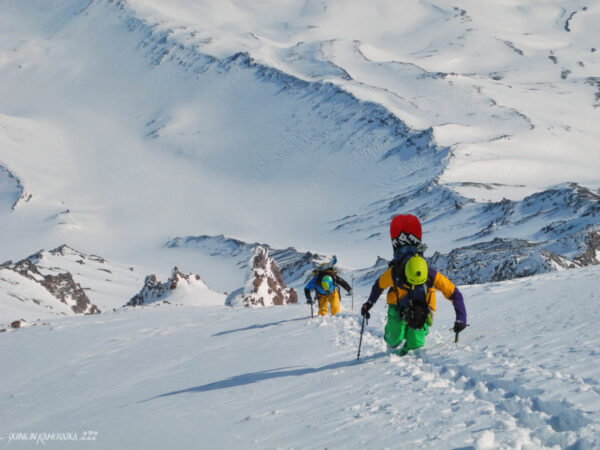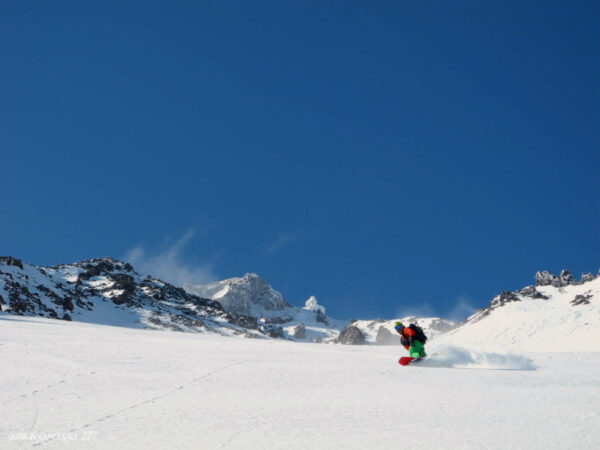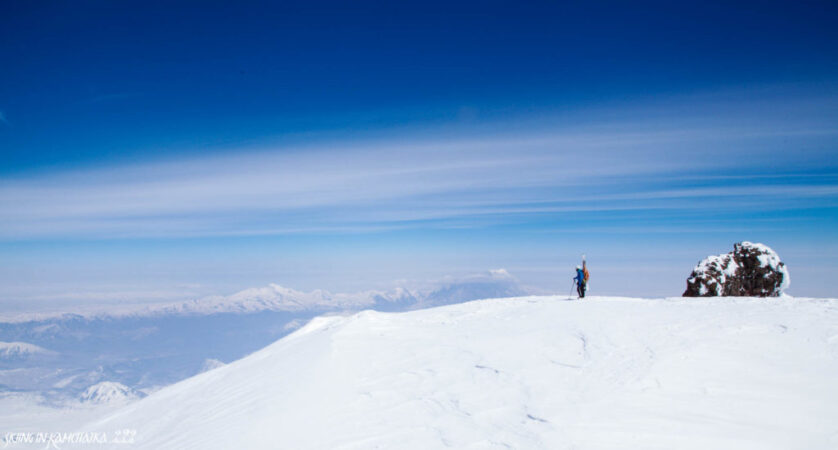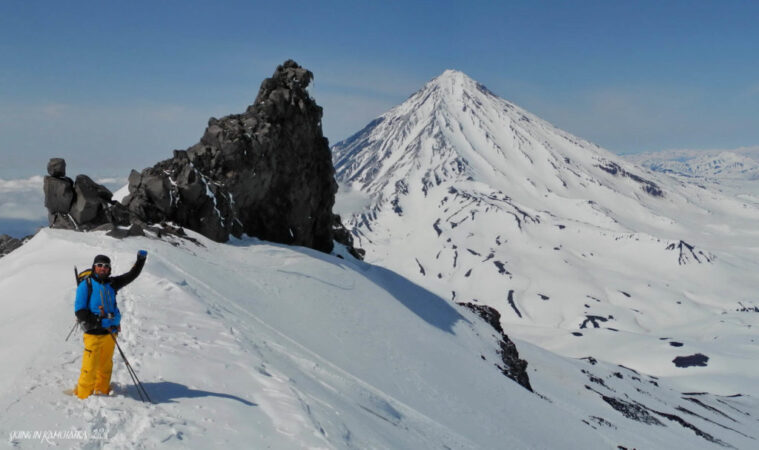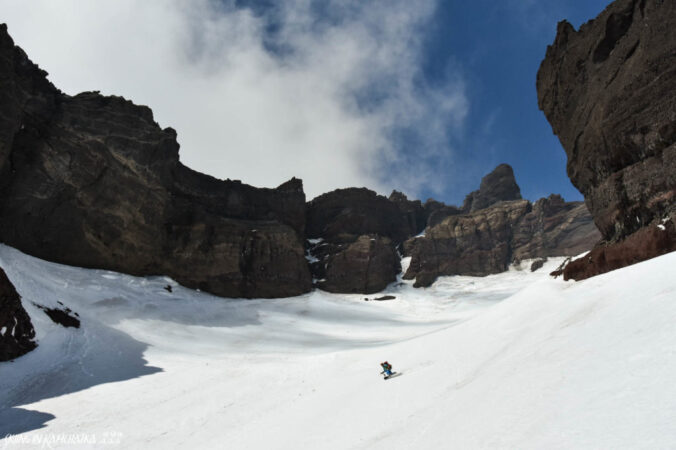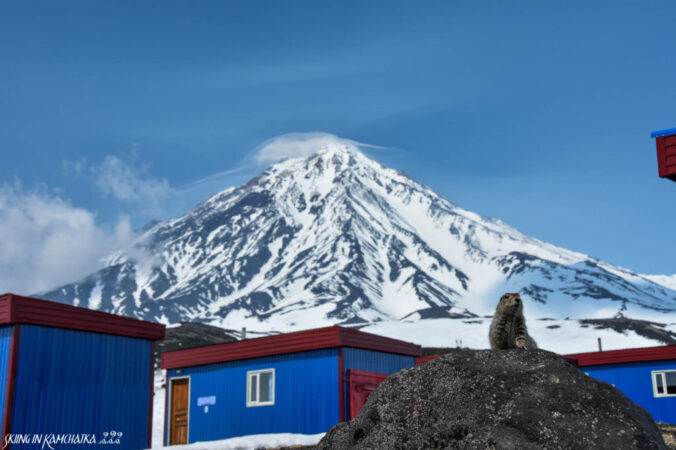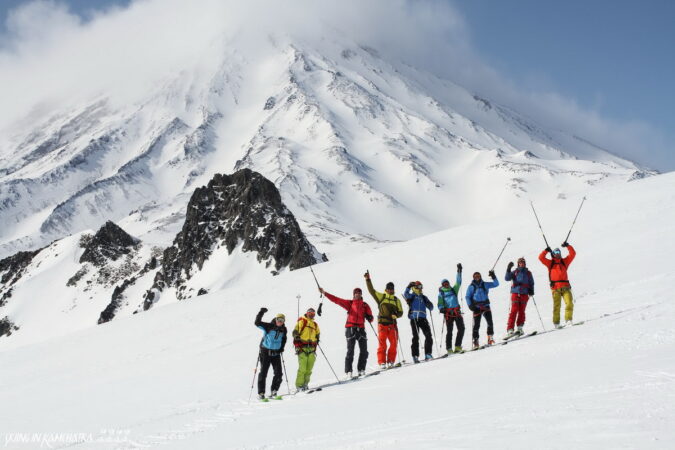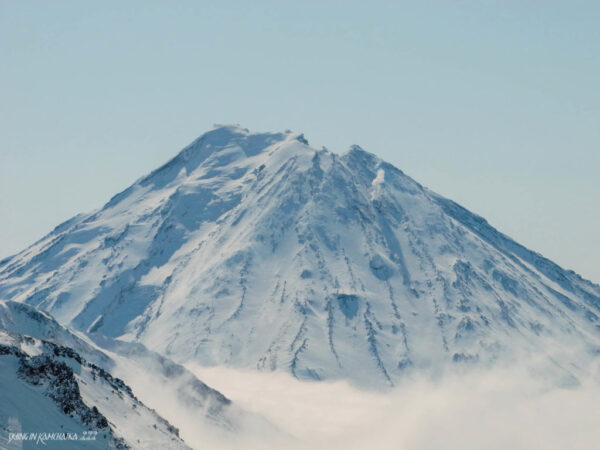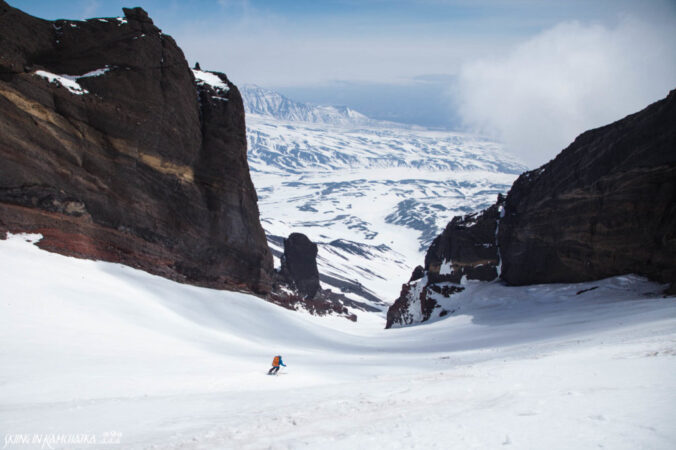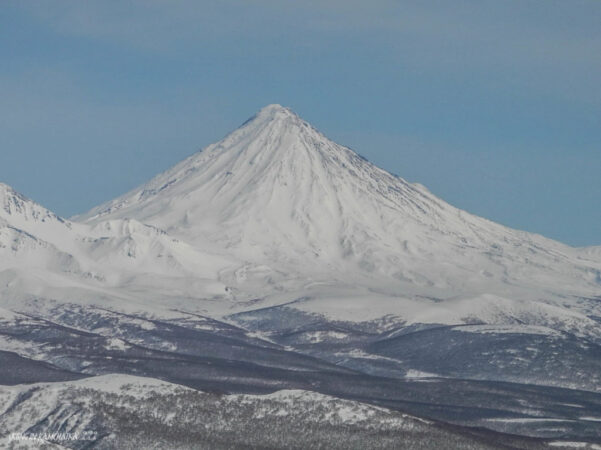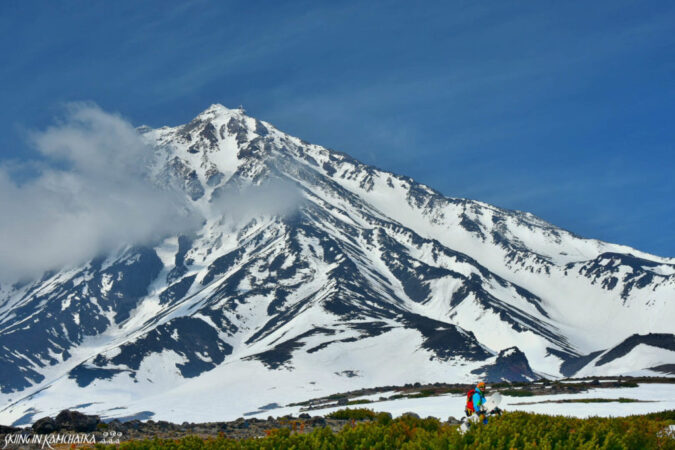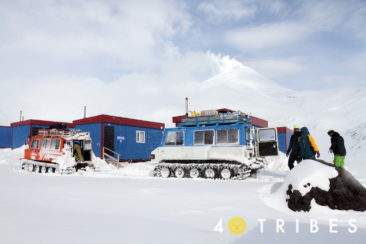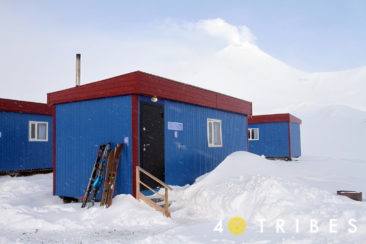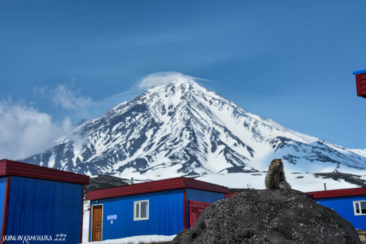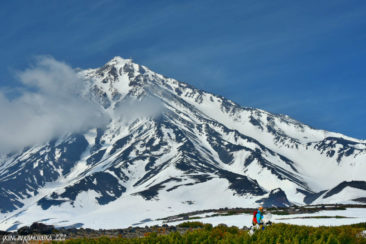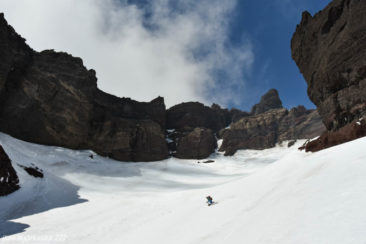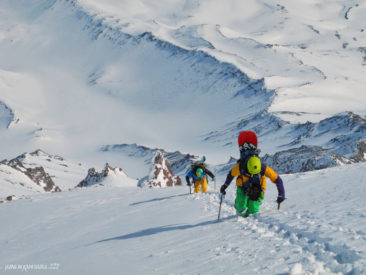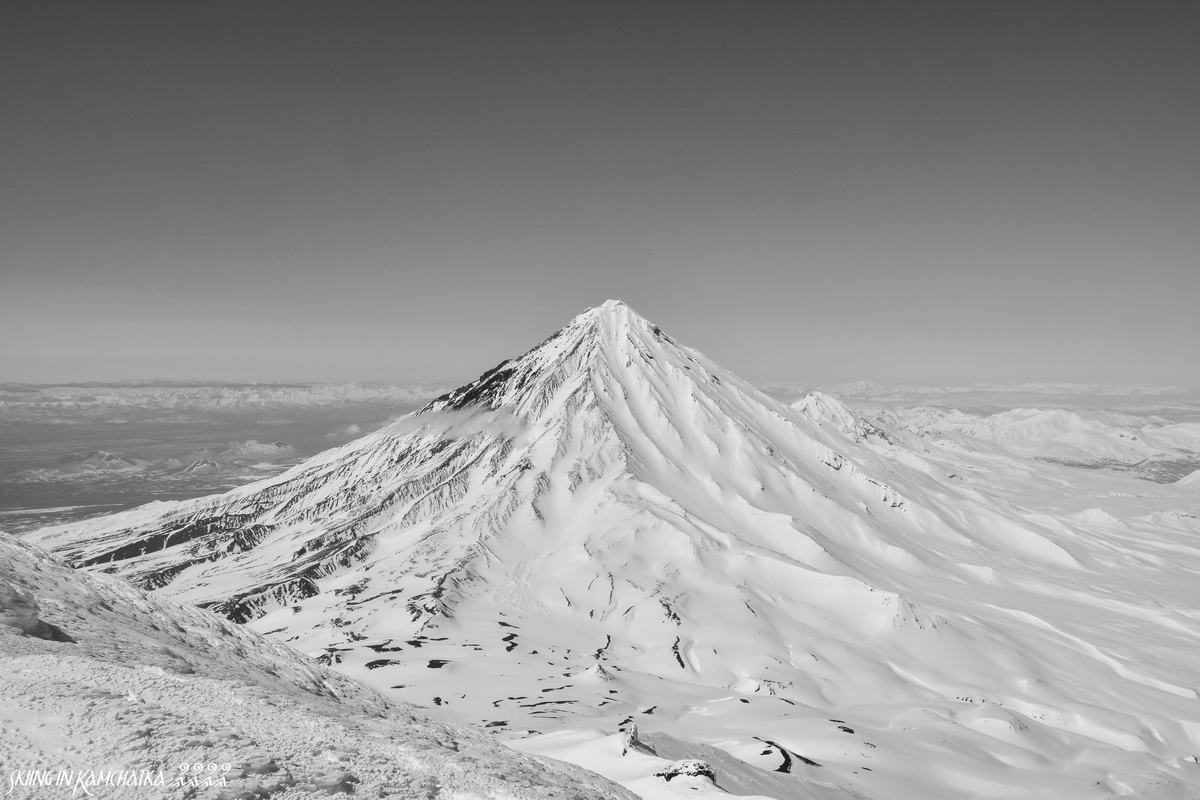
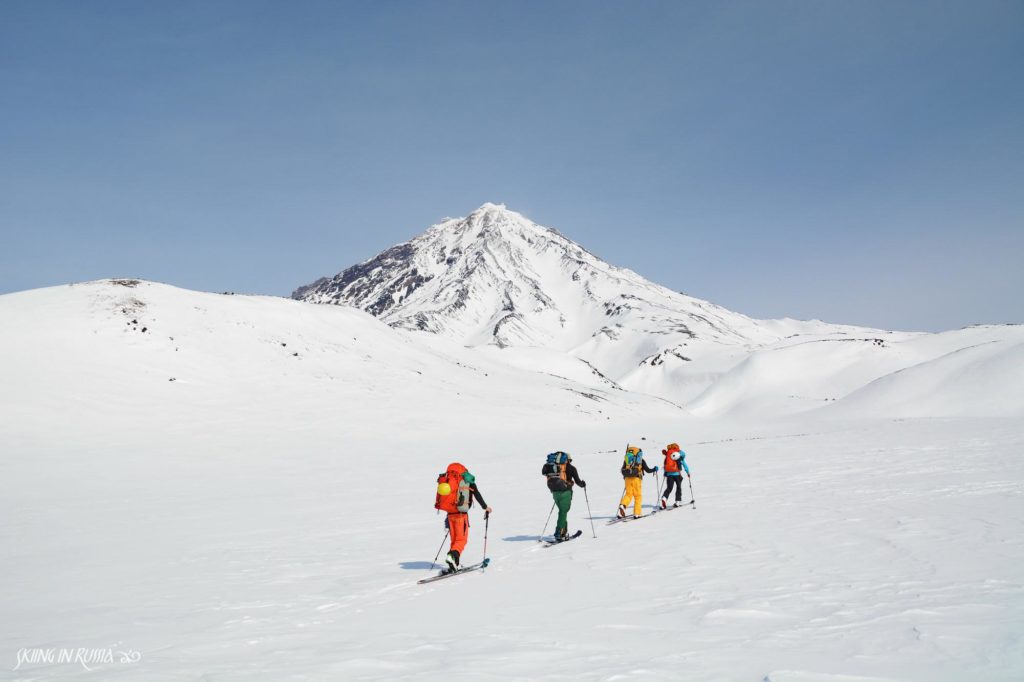
Ascension on Koryaksky volcano
This giant and beautiful volcano greets you at the airport of Petropavlovsk. You see this amazing triangular cone as soon as you step off the plane. This stratovolcano of 3456m is a terrific place for ski mountaineering: Dozens of couloirs and lines leading from the top down almost every aspect, with vertical drops of up to 2700m. Ascension requires you to be in very good physical shape and ski mountaineering skills are needed. In a good weather the scenery from the summit is simply breathtaking. On some days the visibility has been up to 250 kilometres!
Depending on the route we choose, we are based in mountain huts between Koryaksky and Avachinsky volcanoes or in a tent camp. On our classic programme we stay in a mountain hut at 900m, where we travel by snowmobiles or snowcats. From there we can do day trips for skitouring and acclimatization. Depending on the physical abilities of the group, ascension is either possible over two days, with an advanced camp at 2000m, or in just one day, which requires excellent physical fitness.
Period: from mid-April until mid-June
This is a custom programme, by request for private groups.
Booking
Approximate Itinerary (can vary on your request):
Day 1: Arriving in Petropavlovsk; accommodation in Petropavlovsk; meet the guides, gear check; rest time.
Day 2: Morning drive to the foot of Avachinsky volcano; transfer to the pass by snowcat; avalanche training; skitouring on the nearby slopes.
Days 3-7: Skitouring on Koryaksky and Avachinsky volcanoes; ascension.
Day 8: Return to Petropavlovsk.
Day 9: Departure.
In our experience, allowing for acclimatization and bad weather days, you need to spend 5-6 days on the pass in order to reach the summit.
Depending on group abilities, ascension is possible in two days or one day.
Two days ascension itinerary: First day – ascension to advanced camp at 2000m; set up camp; elevation gain of 1100m. Second day - early morning start; elevation gain 1500m; summit about noon; start skiing down towards advanced camp; pack up advanced camp; continue skiing down to mountain huts.
One day ascension itinerary: Start ascent about 3 AM; summit early afternoon, elevation gain 2600m; ski down to mountain huts. We don’t have to finish descent at the mountain huts, as long as they can be reached within 1 hour of easy touring: Therefore we can choose the best line down.
The first option is easier physically, but we are bound to return to advanced camp and pack it up, which reduces our choices of ski routes down. The second option is significantly more challenging, but gives us freedom in the line choice.
Due to the high latitude and specific climate, in Kamchatka you may feel altitude sickness earlier than in other mountain areas. 3000 meters in Kamchatka feel equal to approximately 4000m in the Alps. Due to this, the last 600-700m of ascension can be more difficult and the pace will be slower.
Besides the classic route (ascension and skiing on the aspect from North-East to South-East), there are other options on South or North-West aspects. Please ask us for details.
Program Logistics
There are two daily flights from Moscow (SVO or VKO) to Petropavlovsk-Kamchatsky (PKC), by Aeroflot and Rossiya.
Also, there are few flights fom Vladivostok (VVO) and Khabarovsk (KHV), which can work for flights from Asia or Australia.
Please, check current flight information on the air-company's websites.
Transfer from airport to Petropavlovsk takes 40-50 minutes.
Avachinsky pass mountain base.
Mountain base on Avachinsky pass is surrounded by big volcanoes and has a nice view on the valley. Huts are simple, but warm (heated by wooden stoves) and clean. Dining room and Banya are separate buildings. The huts has a capacity for maximum 10 people, but in our programs we limit it with maximum 5 persons per hut, to provide the comfort and more space.
Winter tent camping.
For south or west routes we use a tent camp, cause there is no mountain hut.
Our base camp features a comfortable cooking/dining tent warmed by a gas or wooden heater, along with separate 4-season, 2-person sleeping tents.With a heater you will be able not only warm up if you get cold but also dry the clothes and gear, in cloudy days (when it is sunny, it is easy to dry the stuff on the sun). Toilet is a separate toilet tent.
In our modern world, with widespread mountain huts, not many people camp in the winter. But for places such as Kamchatka, it is essential as there is no other way to explore the mountains. Many of our guests, who have never experienced winter camping before, tell us it is way easier and more comfortable than they expected. With a spacious, heated dining tent, you have space to comfortably sit, chat with new friends and enjoy your meals in a comfortable and warm atmosphere. With your warm sleeping bag and mat, after a substantial dinner, you sleep well in your tent and wake up in the morning to the smell of hot coffee from the dining tent. Life in a winter tent camp is probably easier than you imagine! There are several little tips to make life in a winter camp easier, and our guides will be glad to share their knowledge with you.
Meals
We do our best to make the meals, as well as the skiing, a remarkable part of your trip. We include traditional Kamchatka products, such as fish, seafood, reindeer meat and wild plants. Our chefs are all greatly experienced in winter camp cooking and will provide meals that are tasty, healthy and nutritious.
There are three hot meals a day. Here are some examples of the menu:
- Breakfast: cold breakfast - cereal/muesli with milk or yoghurt; hot breakfast - fried eggs, bacon/sausages, pancakes. Tea, coffee.
- Mountain lunch: Sandwiches,chocolate bars, dried fruits/ nuts.
- Aprés ski: Smoked salmon or other local fish, fruits.
- Dinner: Local salads; dishes with meat or fish; sides (pasta, rice, potatoes); stewed vegetables. And of course, desserts and herbal teas.
We don’t serve any alcoholic drinks, but you are welcome to bring a reasonable amount of beer, wine or spirits.
We can accommodate special dietary requirements and food allergies. Our guests are asked to complete a registration form, and mention any dietary needs so we can be fully prepared for your arrival. Please note that all food is purchased before the trip starts and we don't have another opportunity to buy anything or change the menu during the trip.
For this programme, maximum guide:guests ratio is 1:2. Groups bigger than 2 persons requires additional guides.
Prerequisites
Because of the nature of the backcountry terrain, we ask our guests to meet a certain level of fitness, skiing and ski-mountaineering abilities. To join our groups, you should be
- High or expert level of skiing/boarding, in any snow conditions, with at least 3 year ski-tour /backcountry experience
- Healthy and in very good/excellent physical shape.
- Able skin up at least 2000 vertical meters per day.
- Advanced or higher level of ski-mountaineering (confident user of boot crampons and ice-axe on a hard snow, with steepness up to 35 deg.).
Terrain
The couloirs of Koryakskiy volcano are fabulously wide and steep, with smooth terrain and endless, non-stop runs. And of course, with glorious scenery at every turn. Skiing in upper part may be a bit tricky, with steep sections on hard snow and some navigation between the rocks.
Skiing
Depend on the month, aspect and weather conditions, we can ski all kinds of snow, from deep powder to corn, spring snow. We will discuss the specific conditions for the period you choose, or advise a period depending on your skiing preferences.
Weather
Although Kamchatka lies at a similar latitude to Great Britain, cold Arctic winds from Siberia combined with the cold Ohotskoe sea current cover the peninsula in snow from October to late June.
Winter months are known for their low temperatures and strong winds, which is why volcano skiing is not enjoyable then. The Spring months bring more comfortable weather - warmer, but still bringing snowfall which transforms into light powder until the end of April, or even the beginning of May up high.
As everywhere, bad weather happens. But generally the weather is stable in April-May and cyclones don’t last long. In fact last year’s statistics show we were skitouring/splitboarding about 90 percent of the time.
You can check the weather forecast for our skitouring zones here – Koryaksky volcano, Petropavlovsk-Kamchatsky.
Visa and Insurance
To travel to Russia, most foreign nationals are required to have an Entry Visa to Russia. Russian visas can be obtained at your local Russian Embassy or Consulate. In order to apply for a visa you will need proof of your forthcoming visit to Russia, which will be supplied by Skiing In Kamchatka on receipt of your final payment. Provided all the documents are ready, the process usually takes no more than 3-10 working days for a Russian Tourist Visa. It is also possible to ask special agencies for a full visa service.
We will need copy of your visa in 1 month before arrival. This is official government rule, because of border proximity. So, please apply for visa in advance. But even if you decide to come in a last moment, this question can be solved personally.
Insurance
Being adequately insured is a condition of booking a trip with Skiing in Kamchatka. You must have travel and medical insurance, which covers backcountry skiing (skitouring/splitboarding), ski-mountaineering and helicopter rescue. For your peace of mind and to avoid any financial hardship that an unexpected cancellation could cause, we strongly recommend getting Trip Cancellation insurance.
Time in Petropavlovsk-Kamchatsky - GMT+12
There are 3 mobile operators covering populated areas of Kamchatka. On the Avachinsky pass all 3 are available. We will not have WiFi on Avachinsky pass, but you will be able to use mobile internet on your phone. Please, keep in mind, we do not guarantee cellular coverage when we are in the mountains. Our guides always have satellite phones/messenger for emergency use.
Language
Not many people in Russia speak a foreign language (more likely in big towns, less in the countryside). But people are helpful and will easily understand what you need. The alphabet is Cyrillic so reading can be difficult. If you wish to practice your Russian, we recommend you purchase a phrase-book in advance.
During your trip, you will be accompanied by an English-speaking guide. Some of our Ski Guides speak German and French as well, but our general language is English. For private groups, we can try to arrange the guide who speaks your language.
Money
The Russian currency is the Rouble (RUB). No other currencies are accepted for payments. Cards are accepted in most big shops, hotels and restaurants, but this type of payment is still not as wide-spread as in Europe or North America. We strongly recommend that you have enough cash with you for the whole holiday. You can change money in banks (closed on weekends and national holidays) or use an ATM (there are plenty in all towns and cities). You might need some cash during program, take it into consideration.
Moscow transit
There are three international airports in Moscow; Domodedovo (DME), Sheremetyevo (SVO), and Vnukovo (VKO). Depending on your flight plan, you might need to change airports which can be a time consuming. If you do need to change airports, we strongly recommend you allow at least 2 hours for your airport-to-airport transfers.
Please service your skis or board before arrival, or bring pocket waxes as there is no ski-service at our base. We have some repair parts and tools to fix most common problems which might arise, but we do not have equipment for hot waxing.
We advise you to carefully read the following list. You will not be able to buy or rent the equipment out here, so do bring everything with you. If you have any questions about equipment or items on (or not on) this list please don’t hesitate to email and ask for advice.
Here is an example of set of clothes that we recommend. You can change it according to your preferences, but be sure that your clothes suit the weather and temperature during your trip.
Clothing:
- Weather Layer Top - Gore-Tex/Softshell or other waterproof breathable jacket
- Weather Layer Pants - Gore-Tex/Softshell or other waterproof breathable pants
- Warm jacket – Primaloft or similar
- Down/synthetic jacket and overpants warm to minus 10 C., for bivouac.
- Mid-Insulation Layer Top - Polartec 100 or analogue
- Base Layer Top and Bottom, mid or warm – 2 pieces each
- Mid weight socks - 2-3 pairs
- Hat
- Sun cap
- Light gloves
- Insulated gloves or mittens
- Camp winter boots
Ski gear:
- Skis or Splitboard
- Skins. Glue should be in good condition, renew if necessary.
- Touring Boots
- Ski crampons
- Telescopic Poles
- Ski helmet
- Binding/Boot/Pole/Skin Repair Kit - tools and parts to fix your personal gear
Ski-mountaineering gear:
- Boot crampons, compatible with your boots. Steel only, 10/12-points
- Ice axe, 55-65 cm.
- Lightweight harness (Black Diamond Couloir or analogue)
- Carabiner, pear-shaped – 2 pc.
- Dyneema sling, 120-180cm.
Avalanche gear:
- Transceiver (two antenna minimum), extra batteries.
- Probe
- Shovel
Personal equipment:
- Backpack, 55-65 litres, which contains all your personal gear and has extra space for the food/fuel.
- Duffel, for carrying your stuff by snowmobile, water resistant.
- Personal First Aid kit, blister kit.
- Thermos, 0.5-0.7 litres
- Water flask, 1 litre
- Sunglasses, plus extra pair (CE rated 3 or 4)
- Ski goggles
- Headlamp with extra batteries
- Personal toiletries, light synthetic towel.
- Sun/Cold and Lip Cream (SPF30 or higher)
- Earplugs
Camp gear:
- Winter sleeping bag (rated to -20C or warmer). Synthetic is preferable.
- Sleeping pad, 4-seasons (R-value of 3.5 or higher).
We provide spacious 2-person tents, dishes and utensils.
If you prefer to sleep alone, or feel you may disturb your neighbour (snoring, etc.), we strongly recommend you bring a 1-person tent or let us know in advance and we will try to provide personal tent for you.
Approximate Itinerary (can vary on your request):
Day 1: Arriving in Petropavlovsk; accommodation in Petropavlovsk; meet the guides, gear check; rest time.
Day 2: Morning drive to the foot of Avachinsky volcano; transfer to the pass by snowcat; avalanche training; skitouring on the nearby slopes.
Days 3-7: Skitouring on Koryaksky and Avachinsky volcanoes; ascension.
Day 8: Return to Petropavlovsk.
Day 9: Departure.
In our experience, allowing for acclimatization and bad weather days, you need to spend 5-6 days on the pass in order to reach the summit.
Depending on group abilities, ascension is possible in two days or one day.
Two days ascension itinerary: First day – ascension to advanced camp at 2000m; set up camp; elevation gain of 1100m. Second day - early morning start; elevation gain 1500m; summit about noon; start skiing down towards advanced camp; pack up advanced camp; continue skiing down to mountain huts.
One day ascension itinerary: Start ascent about 3 AM; summit early afternoon, elevation gain 2600m; ski down to mountain huts. We don’t have to finish descent at the mountain huts, as long as they can be reached within 1 hour of easy touring: Therefore we can choose the best line down.
The first option is easier physically, but we are bound to return to advanced camp and pack it up, which reduces our choices of ski routes down. The second option is significantly more challenging, but gives us freedom in the line choice.
Due to the high latitude and specific climate, in Kamchatka you may feel altitude sickness earlier than in other mountain areas. 3000 meters in Kamchatka feel equal to approximately 4000m in the Alps. Due to this, the last 600-700m of ascension can be more difficult and the pace will be slower.
Besides the classic route (ascension and skiing on the aspect from North-East to South-East), there are other options on South or North-West aspects. Please ask us for details.
Program Logistics
There are two daily flights from Moscow (SVO or VKO) to Petropavlovsk-Kamchatsky (PKC), by Aeroflot and Rossiya.
Also, there are few flights fom Vladivostok (VVO) and Khabarovsk (KHV), which can work for flights from Asia or Australia.
Please, check current flight information on the air-company's websites.
Transfer from airport to Petropavlovsk takes 40-50 minutes.
Accommodation
Avachinsky pass mountain base.
Mountain base on Avachinsky pass is surrounded by big volcanoes and has a nice view on the valley. Huts are simple, but warm (heated by wooden stoves) and clean. Dining room and Banya are separate buildings. The huts has a capacity for maximum 10 people, but in our programs we limit it with maximum 5 persons per hut, to provide the comfort and more space.
Winter tent camping.
For south or west routes we use a tent camp, cause there is no mountain hut.
Our base camp features a comfortable cooking/dining tent warmed by a gas or wooden heater, along with separate 4-season, 2-person sleeping tents.With a heater you will be able not only warm up if you get cold but also dry the clothes and gear, in cloudy days (when it is sunny, it is easy to dry the stuff on the sun). Toilet is a separate toilet tent.
In our modern world, with widespread mountain huts, not many people camp in the winter. But for places such as Kamchatka, it is essential as there is no other way to explore the mountains. Many of our guests, who have never experienced winter camping before, tell us it is way easier and more comfortable than they expected. With a spacious, heated dining tent, you have space to comfortably sit, chat with new friends and enjoy your meals in a comfortable and warm atmosphere. With your warm sleeping bag and mat, after a substantial dinner, you sleep well in your tent and wake up in the morning to the smell of hot coffee from the dining tent. Life in a winter tent camp is probably easier than you imagine! There are several little tips to make life in a winter camp easier, and our guides will be glad to share their knowledge with you.
Meals
We do our best to make the meals, as well as the skiing, a remarkable part of your trip. We include traditional Kamchatka products, such as fish, seafood, reindeer meat and wild plants. Our chefs are all greatly experienced in winter camp cooking and will provide meals that are tasty, healthy and nutritious.
There are three hot meals a day. Here are some examples of the menu:
- Breakfast: cold breakfast - cereal/muesli with milk or yoghurt; hot breakfast - fried eggs, bacon/sausages, pancakes. Tea, coffee.
- Mountain lunch: Sandwiches,chocolate bars, dried fruits/ nuts.
- Aprés ski: Smoked salmon or other local fish, fruits.
- Dinner: Local salads; dishes with meat or fish; sides (pasta, rice, potatoes); stewed vegetables. And of course, desserts and herbal teas.
We don’t serve any alcoholic drinks, but you are welcome to bring a reasonable amount of beer, wine or spirits.
We can accommodate special dietary requirements and food allergies. Our guests are asked to complete a registration form, and mention any dietary needs so we can be fully prepared for your arrival. Please note that all food is purchased before the trip starts and we don't have another opportunity to buy anything or change the menu during the trip.
Guiding &Group Size
For this programme, maximum guide:guests ratio is 1:2. Groups bigger than 2 persons requires additional guides.
Prerequisites
Because of the nature of the backcountry terrain, we ask our guests to meet a certain level of fitness, skiing and ski-mountaineering abilities. To join our groups, you should be
- High or expert level of skiing/boarding, in any snow conditions, with at least 3 year ski-tour /backcountry experience
- Healthy and in very good/excellent physical shape.
- Able skin up at least 2000 vertical meters per day.
- Advanced or higher level of ski-mountaineering (confident user of boot crampons and ice-axe on a hard snow, with steepness up to 35 deg.).
Terrain
The couloirs of Koryakskiy volcano are fabulously wide and steep, with smooth terrain and endless, non-stop runs. And of course, with glorious scenery at every turn. Skiing in upper part may be a bit tricky, with steep sections on hard snow and some navigation between the rocks.
Skiing
Depend on the month, aspect and weather conditions, we can ski all kinds of snow, from deep powder to corn, spring snow. We will discuss the specific conditions for the period you choose, or advise a period depending on your skiing preferences.
Weather
Although Kamchatka lies at a similar latitude to Great Britain, cold Arctic winds from Siberia combined with the cold Ohotskoe sea current cover the peninsula in snow from October to late June.
Winter months are known for their low temperatures and strong winds, which is why volcano skiing is not enjoyable then. The Spring months bring more comfortable weather - warmer, but still bringing snowfall which transforms into light powder until the end of April, or even the beginning of May up high.
As everywhere, bad weather happens. But generally the weather is stable in April-May and cyclones don’t last long. In fact last year’s statistics show we were skitouring/splitboarding about 90 percent of the time.
You can check the weather forecast for our skitouring zones here – Koryaksky volcano, Petropavlovsk-Kamchatsky.
Visa and Insurance
To travel to Russia, most foreign nationals are required to have an Entry Visa to Russia. Russian visas can be obtained at your local Russian Embassy or Consulate. In order to apply for a visa you will need proof of your forthcoming visit to Russia, which will be supplied by Skiing In Kamchatka on receipt of your final payment. Provided all the documents are ready, the process usually takes no more than 3-10 working days for a Russian Tourist Visa. It is also possible to ask special agencies for a full visa service.
We will need copy of your visa in 1 month before arrival. This is official government rule, because of border proximity. So, please apply for visa in advance. But even if you decide to come in a last moment, this question can be solved personally.
Insurance
Being adequately insured is a condition of booking a trip with Skiing in Kamchatka. You must have travel and medical insurance, which covers backcountry skiing (skitouring/splitboarding), ski-mountaineering and helicopter rescue. For your peace of mind and to avoid any financial hardship that an unexpected cancellation could cause, we strongly recommend getting Trip Cancellation insurance.
Time in Petropavlovsk-Kamchatsky - GMT+12
There are 3 mobile operators covering populated areas of Kamchatka. On the Avachinsky pass all 3 are available. We will not have WiFi on Avachinsky pass, but you will be able to use mobile internet on your phone. Please, keep in mind, we do not guarantee cellular coverage when we are in the mountains. Our guides always have satellite phones/messenger for emergency use.
Language
Not many people in Russia speak a foreign language (more likely in big towns, less in the countryside). But people are helpful and will easily understand what you need. The alphabet is Cyrillic so reading can be difficult. If you wish to practice your Russian, we recommend you purchase a phrase-book in advance.
During your trip, you will be accompanied by an English-speaking guide. Some of our Ski Guides speak German and French as well, but our general language is English. For private groups, we can try to arrange the guide who speaks your language.
Money
The Russian currency is the Rouble (RUB). No other currencies are accepted for payments. Cards are accepted in most big shops, hotels and restaurants, but this type of payment is still not as wide-spread as in Europe or North America. We strongly recommend that you have enough cash with you for the whole holiday. You can change money in banks (closed on weekends and national holidays) or use an ATM (there are plenty in all towns and cities). You might need some cash during program, take it into consideration.
Moscow transit
There are three international airports in Moscow; Domodedovo (DME), Sheremetyevo (SVO), and Vnukovo (VKO). Depending on your flight plan, you might need to change airports which can be a time consuming. If you do need to change airports, we strongly recommend you allow at least 2 hours for your airport-to-airport transfers.
Please service your skis or board before arrival, or bring pocket waxes as there is no ski-service at our base. We have some repair parts and tools to fix most common problems which might arise, but we do not have equipment for hot waxing.
We advise you to carefully read the following list. You will not be able to buy or rent the equipment out here, so do bring everything with you. If you have any questions about equipment or items on (or not on) this list please don’t hesitate to email and ask for advice.
Here is an example of set of clothes that we recommend. You can change it according to your preferences, but be sure that your clothes suit the weather and temperature during your trip.
Clothing:
- Weather Layer Top - Gore-Tex/Softshell or other waterproof breathable jacket
- Weather Layer Pants - Gore-Tex/Softshell or other waterproof breathable pants
- Warm jacket – Primaloft or similar
- Down/synthetic jacket and overpants warm to minus 10 C., for bivouac.
- Mid-Insulation Layer Top - Polartec 100 or analogue
- Base Layer Top and Bottom, mid or warm – 2 pieces each
- Mid weight socks - 2-3 pairs
- Hat
- Sun cap
- Light gloves
- Insulated gloves or mittens
- Camp winter boots
Ski gear:
- Skis or Splitboard
- Skins. Glue should be in good condition, renew if necessary.
- Touring Boots
- Ski crampons
- Telescopic Poles
- Ski helmet
- Binding/Boot/Pole/Skin Repair Kit - tools and parts to fix your personal gear
Ski-mountaineering gear:
- Boot crampons, compatible with your boots. Steel only, 10/12-points
- Ice axe, 55-65 cm.
- Lightweight harness (Black Diamond Couloir or analogue)
- Carabiner, pear-shaped – 2 pc.
- Dyneema sling, 120-180cm.
Avalanche gear:
- Transceiver (two antenna minimum), extra batteries.
- Probe
- Shovel
Personal equipment:
- Backpack, 55-65 litres, which contains all your personal gear and has extra space for the food/fuel.
- Duffel, for carrying your stuff by snowmobile, water resistant.
- Personal First Aid kit, blister kit.
- Thermos, 0.5-0.7 litres
- Water flask, 1 litre
- Sunglasses, plus extra pair (CE rated 3 or 4)
- Ski goggles
- Headlamp with extra batteries
- Personal toiletries, light synthetic towel.
- Sun/Cold and Lip Cream (SPF30 or higher)
- Earplugs
Camp gear:
- Winter sleeping bag (rated to -20C or warmer). Synthetic is preferable.
- Sleeping pad, 4-seasons (R-value of 3.5 or higher).
We provide spacious 2-person tents, dishes and utensils.
If you prefer to sleep alone, or feel you may disturb your neighbour (snoring, etc.), we strongly recommend you bring a 1-person tent or let us know in advance and we will try to provide personal tent for you.



